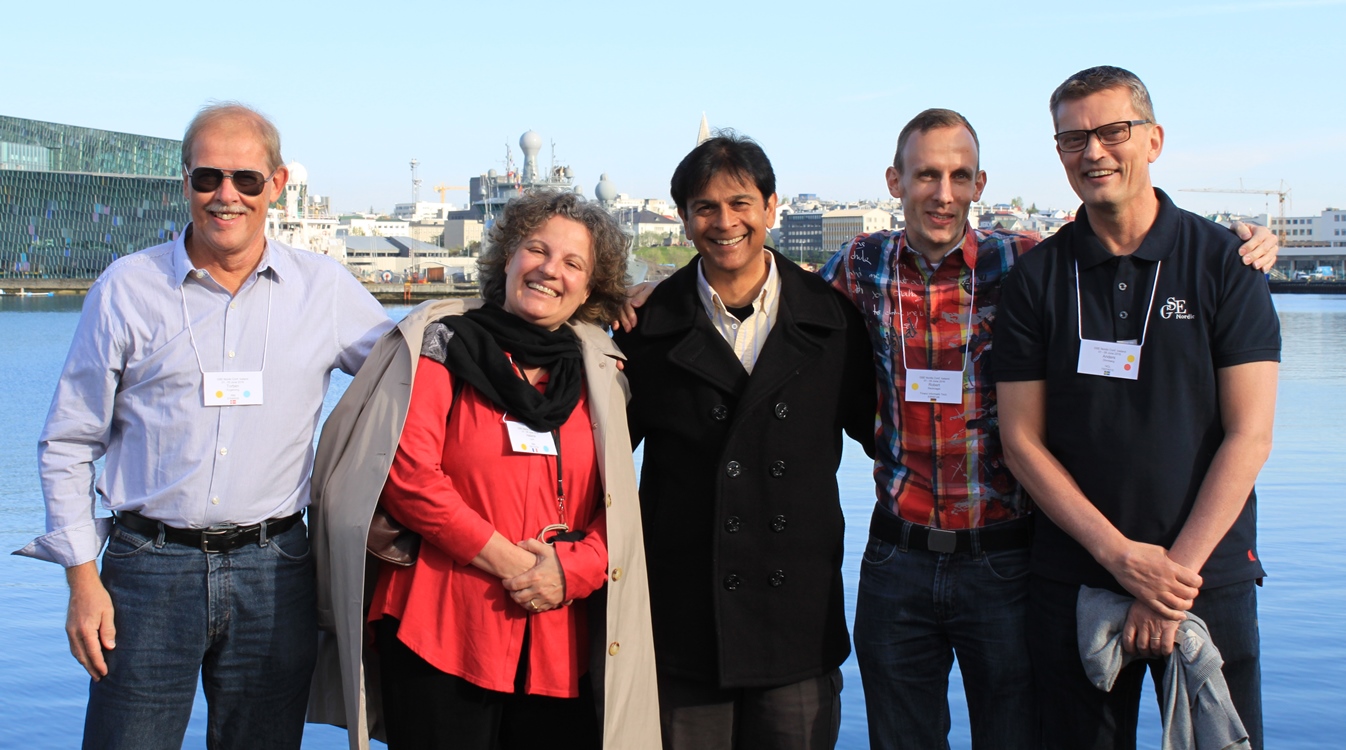
Robert Recknagel bei der Fjallsárlón Glacier Lagoon
Kürzlich war ich für FI-TS auf der GSE Nordic Region Conference in Reykjavík, Island und habe bereits zum zweiten Mal in Folge auf dieser Konferenz präsentiert. Dieses Jahr war das Thema die Integration hierarchischer Datenbanken sowie Transaktionsanwendungen des Mainframe Transaktions- und Datenbankmanagementsystems IMS in Java Enterprise-Anwendungen unter Linux, Unix oder Windows sowie der Einsatz von Java als Programmiersprache für IMS-Transaktionsanwendungen. Die Präsentation war ein voller Erfolg, denn nicht nur IMS-Systemprogrammierer und -Datenbankadministratoren, sondern auch Java-Entwickler haben sie besucht und konnten dank Unterstützung von IBM in der zweistündigen Session (Präsentation & Instruktionen) eine eigene Anwendung auf Basis dieser Technologien implementieren.
Themen, wie dieses, sind wichtig, denn weltweit kämpfen viele Firmen, die den Mainframe einsetzen, mit Nachwuchsproblemen. Betroffen davon sind oft auch Firmen, die ihren Betrieb an einen Dienstleister ausgelagert haben – denn auch Anwendungsentwickler mit Assembler-, COBOL- oder PL/I-Kenntnissen sind immer schwieriger zu finden. Umso wichtiger ist es frühzeitig eine Strategie zur Anwendungsmodernisierung auf dem Mainframe zu haben und sich diesbezüglich von IBM oder seinem Provider beraten zu lassen. Dass FI-TS regelmäßig auf Konferenzen wie der GSE Nordic Region Conference zu diesem Thema präsentiert, verdeutlicht, dass wir über das notwendige Knowhow verfügen, unsere Kunden diesbezüglich zu beraten und bei Bedarf auch zu unterstützen – und das obwohl FI-TS selbst keine Anwendungsentwicklung betreibt.

Von links nach rechts: Torben Flygenring (Europe IMS Software Architect Team, IBM Denmark), Helene Lyon (CTO Real-Time Analytics on z Systems for Europe, IBM France), Deepak Kohli (IMS Product Management Team, IBM United States), Robert Recknagel (Team leader DB/DC systems, FI-TS Germany) and Anders Öhrnberg (GSE Nordic IMS Working Group Chairman , HCL Technologies Sweden) im Hafen von Reykjavík
Selbst Gartner informiert mittlerweile darüber, dass Projekte zur Ablösung des Mainframe oft nicht nur langwierig und riskant sind, sondern auch wesentlich teurer als die bestehende Anwendungslandschaft Stück für Stück zu modernisieren, in dem neue Anwendungen basierend auf neuen bzw. zum Teil bereits seit Jahren auf dem Mainframe zur Verfügung stehenden, aber weitestgehend ungenutzte Technologien zu implementieren und bestehende Anwendungen im Zuge anstehender Veränderungen auf Basis dieser Technologien umzubauen. Der Einsatz der Programmiersprache Java auf dem Mainframe ermöglicht es junge Anwendungsentwickler für die Plattform zu begeistern. Es bieten sich zahlreiche Möglichkeiten neu in Java implementierte oder auf Java migrierte Anwendungen mit Altanwendungen zu integrieren. Auf diese Art und Weise haben die Investitionen der letzten Jahrzehnte auch weiterhin Bestand und ganz nebenbei können die vielen Stärken dieser Plattform weiterhin genutzt werden sowie neue Anwendungen davon profitieren.
Java stellt nur eine von vielen Optionen für den Einsatz neuer Technologien auf dem Mainframe dar. So lassen sich beispielsweise mittlerweile hierarchische IMS-Datenbanken mittels SQL-Zugriffen verarbeiten oder CICS- bzw. IMS-Transaktionsanwendungen mittels z/OS Connect als RESTful Services deployen. Es ist nicht nur möglich mittels Standards wie REST auf Mainframe-Anwendungen zuzugreifen, sondern Mainframe-Anwendungen wie zum Beispiel IMS-Transaktionen können genauso auch auf dezentrale Web Services zugreifen. Der Einsatz moderner, standardisierter Technologien erleichtert nicht nur jungen Anwendungsentwicklern den Einstieg in diese Plattform, sondern vereinfacht auch die Konstruktion plattformübergreifender Anwendungen sowie die Anbindung moderner Frontends an teils Jahrzehnte alte, aber immer noch zuverlässige Anwendungen auf dem Mainframe.
In meinem nächsten Blog-Eintrag werde ich konkreter über eine der hier angesprochenen Technologien berichten.

Sonnenuntergang kurz vor Mittwernacht in Reykjavík
Modernizing mainframe applications – FI-TS presents in Iceland (english version)

Robert Recknagel at Fjallsárlón Glacier Lagoon
Recently I was at the GSE Nordic Region Conference in Reykjavík, Iceland for my company FI-TS. I presented at this conference for the second time. This year’s topic was integrating the hierarchical databases and transactional applications of the mainframe transaction and database management system IMS into Java enterprise applications running on either Linux, Unix or Windows. The topic also was about using Java as the programming language for applications running under IMS control. The presentation was a great success, because not only IMS system programmers and IMS database administrators have been attending but also Java developers. Thanks to IBM’s support, the participants were able to implement their own application based on these technologies during this two hour session (slides and instruction).
It is important to cover topics like this, because worldwide a lot of companies that are using the mainframe have a problem recruiting new young talents. Often this problem also applies to companies that have outsourced their IT, because for them it is difficult to find application developers with Assembler, COBOL or PL/I skills nowadays as well. It is even more important however to find a strategy to modernize mainframe applications at the right time. Concerning the latter IBM or your provider may provide advice. That FI-TS is presenting regularly at international conferences on this topic, shows that we have the know-how to advise and support our customers concerning mainframe application modernization – even though FI-TS itself does not do application development for its customers.

From left to right: Torben Flygenring (Europe IMS Software Architect Team, IBM Denmark), Helene Lyon (CTO Real-Time Analytics on z Systems for Europe, IBM France), Deepak Kohli (IMS Product Management Team, IBM United States), Robert Recknagel (Team leader DB/DC systems, FI-TS Germany) and Anders Öhrnberg (GSE Nordic IMS Working Group Chairman , HCL Technologies Sweden) in the harbour of Reykjavík
By now even Gartner informs that projects aiming to replace the mainframe are often not only lengthy and risky, but also much more expensive than modernizing the existing applications step by step by using new technologies. A lot of these technologies are not really new. IBM has provided these for years, but many companies have not adopted them. Applying these and newer technologies for the implementation of future applications, as well as rebuilding old applications whenever they have to be changed is the key to bring young application developers on the platform. Using Java as the programming language for these new or rebuilt applications is an important step in this direction. There are a lot of possibilities to integrate Java applications with traditional mainframe applications. Facing the skill problems this way helps to preserve the investments made in the last decades and moreover the applications can still take advantage of the strength of this platform.
Java is just one of a plenty of new technologies that can be used on the mainframe. For instance, today it is possible to access hierarchical IMS databases with SQL or to deploy CICS and IMS transactions as RESTful services. The other way around IMS applications can also access distributed web services. Using modern standardized technologies makes it easy for young application developers to get on the platform. Also it simplifies the creation of cross-platform applications and provides new web-based front ends to traditional applications.
In my next blog article I will report on one of the technologies mentioned here in detail.

The sun is sinking over Reykjavík shortly before midnight


